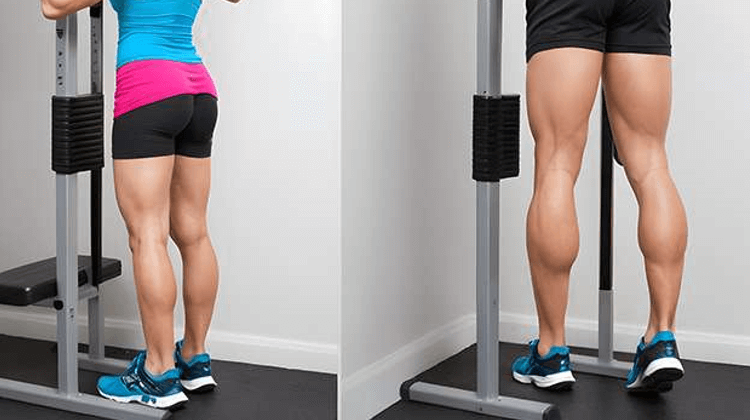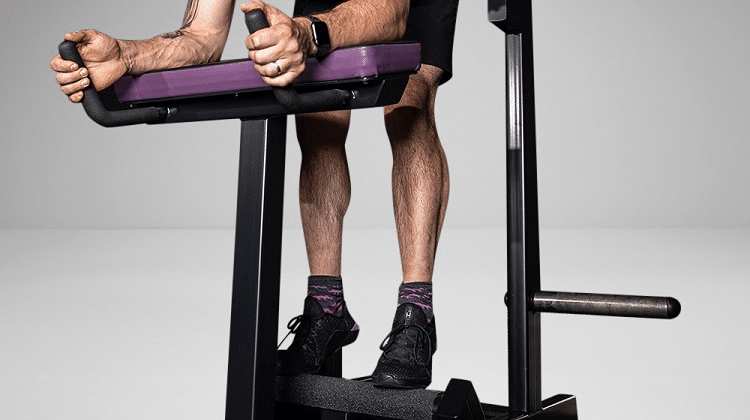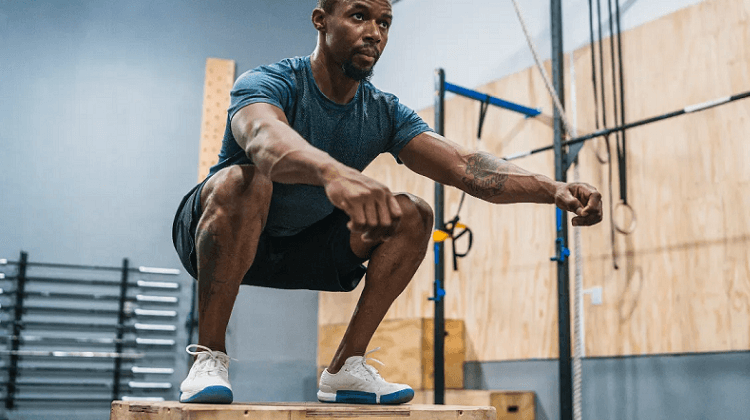Building impressive calf muscles is often overlooked in many workout routines, yet well-developed calves can significantly enhance the overall aesthetics and strength of your legs. Strong calves contribute to better athletic performance, improved balance, and injury prevention.
This comprehensive calf training guide introduces the top 5 exercises designed to increase calf mass. Whether you’re a beginner or an advanced lifter, these exercises will help you achieve strong, defined calves.
1. Standing Calf Raises
Standing calf raises are a fundamental exercise for targeting the gastrocnemius muscle, the largest part of your calf. This exercise is great for building mass and can be easily incorporated into your workout routine.
How to Perform Standing Calf Raises:
1. Positioning:
Stand on a calf raise machine or a step with your heels hanging off the edge. You can also use dumbbells for added resistance if you don’t have access to a machine.
2. Execution:
Push through the balls of your feet, lifting your heels as high as possible.
3. Peak Contraction:
the top position for a moment to maximize muscle contraction.
4. Lowering:
Slowly lower your heels below the step level for a full range of motion.
5. Repetitions (reps):
Perform 3 sets of 12 to 15 reps.
Standing Calf Raises Tips:
Range of Motion:
Focus on a full range of motion for maximum muscle activation.
Knee Position:
Keep your knees slightly bent to reduce tension on your joints.
Posture:
Ensure your body is upright and avoid leaning forward.

Bodybuilding Benefits of Standing Calf Raises
Mass and Strength:
Standing Calf Raises can increase calf size and strength.
Stability:
This calf workout also improves ankle stability and mobility.
Balance:
The Standing Calf Raises exercise enhances overall lower leg muscle balance.
2. Seated Calf Raises
Seated calf raises primarily target the soleus muscle, which lies underneath the gastrocnemius. This exercise is essential for achieving a fuller look to your calves by working on the deeper muscle layers.
How to Perform Seated Calf Raises:
1. Positioning:
Sit on a seated calf raise machine with the balls of your feet on the platform and your knees under the pad.
2. Execution:
Push through the balls of your feet, lifting your heels as high as possible.
3. Peak Contraction:
Hold the top position briefly before lowering your heels back down.
4. Repetitions (reps):
Perform 4 sets of 15 to 20 reps.
Seated Calf Raises Tips:
Weight Adjustment:
Adjust the weight to ensure you can achieve the full range of motion without compromising form.
Control:
Maintain a controlled movement to maximize muscle engagement.
Time Under Tension:
Pause at the top of the movement to increase time under tension.
Bodybuilding Benefits of Seated Calf Raises:
Muscle Targeting:
Seated Calf Raises targets the soleus muscle effectively.
Shape and Definition:
This calf exercise helps in improving the overall shape and definition of the calves.
Endurance:
Seated Calf Raises supports increased endurance and stamina in lower leg muscles.
3. Donkey Calf Raises
Donkey calf raises are an excellent way to engage both the gastrocnemius and soleus muscles with an added stretch due to the bent-over position. This exercise also provides a unique angle for calf development.
How to Perform Donkey Calf Raises:
1. Positioning:
Position yourself on a donkey calf raise machine or lean over a bench with your hips and back flat.
2. Execution:
Place the balls of your feet on the platform and push through your toes, lifting your heels as high as possible.
3. Peak Contraction:
Hold briefly at the top before lowering your heels.
4. Repetitions (reps):
Perform 3 sets of 12 to 15 reps.
Donkey Calf Raises Tips:
Back Position:
Ensure your back remains flat and stable throughout the movement.
Partner Resistance:
If a machine isn’t available, you can perform this exercise with a partner applying resistance on your lower back.
Core Engagement:
Keep your core engaged to maintain balance and control.

Bodybuilding Benefits of Donkey Calf Raises:
Stretch and Flexibility:
This exercise provides a deep stretch for the calves, promoting flexibility.
Muscle Balance:
The Donkey Calf Raises exercise targets both major calf muscles for balanced development.
Leg Power:
This calf workout helps in improving overall leg power and strength.
4. Calf Press on Leg Press Machine
This exercise allows for heavy loading, effectively targeting both the gastrocnemius and soleus muscles. The Calf Press on Leg Press Machine workout combines the benefits of a leg press with the specific focus on calf development.
How to Perform Calf Press on Leg Press Machine Workout:
1. Positioning:
Sit on a leg press machine with the balls of your feet at the bottom edge of the platform.
2. Execution:
Extend your legs fully, but keep a slight bend in your knees. Push through your toes, lifting the platform by extending your ankles.
3. Peak Contraction:
Slowly lower your heels below the platform level.
4. Repetitions (reps):
Perform 4 sets of 10 to 12 reps.
Calf Press on Leg Press Machine Workout Tips:
Knee Position:
Avoid locking your knees completely to prevent joint strain.
Controlled Motion:
Use a controlled motion to avoid bouncing the weight.
Weight Adjustment:
Adjust the weight to ensure you can maintain proper form throughout the sets.
Bodybuilding Benefits of the Calf Press on Leg Press Machine Exercise:
Heavy Resistance:
The Calf Press on Leg Press Machine workout allows for heavy resistance training, promoting muscle growth.
Strength and Endurance:
The Calf Press on Leg Press Machine workout enhances strength and endurance in the calves.
Stable Environment:
The Calf Press on Leg Press Machine workout provides a stable environment to focus on muscle contraction.
5. Box Jumps
Box jumps are a plyometric exercise that not only builds calf mass, but also improves overall leg power and explosiveness. This dynamic movement is also excellent for enhancing athletic performance.
How to Perform Box Jumps:
1. Positioning:
Stand in front of a sturdy box or platform.
2. Execution:
Jump onto the box, driving through your calves and using your arms for momentum.
3. Landing:
Land softly with your knees slightly bent.
4. Repetitions (reps):
Step back down and repeat. Perform 3 sets of 10 to 12 reps.
Box Jumps Tips:
Soft Landing:
Focus on landing softly to minimize impact on your joints.
Box Height:
Start with a lower box if you are new to box jumps and gradually increase the height as you gain confidence and strength.
Arm Use:
Use your arms to help propel your body upward.

Bodybuilding Benefits of Box Jumps:
Explosiveness:
Box Jumps improve explosiveness and overall leg strength.
Coordination:
Box Jumps tend to engage multiple muscle groups, enhancing coordination and balance.
Cardio:
Box Jumps burn calories and increase cardiovascular endurance.
Ready to transform your calves? Incorporate these 5 calf training exercises into your leg day routine and track your progress. Consistency is key, so ensure you are following these exercises regularly, progressively increasing the weights and intensity as you go.
Share your results and experiences with others to stay motivated and inspire those around you. Join fitness communities, engage in discussions, and seek feedback to continually improve your form and effectiveness. Also, actively seek out mentors, at Anabolic Coach, we offer free coaching to anyone willing to put in the required hard work to succeed.
Conclusion
Developing strong, muscular calves requires dedication and the right exercises. By integrating these top 5 calf training exercises into your workout routine, you will not only increase your calf mass, but also enhance your overall leg strength and appearance.
However, always listen to your body, ensure proper form, and allow adequate recovery time between workouts. Embrace the journey to bigger, stronger calves and enjoy the process of becoming a more powerful version of yourself. Happy training!

